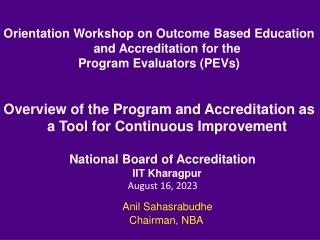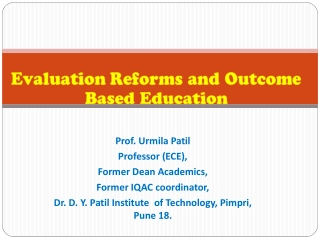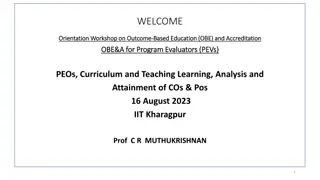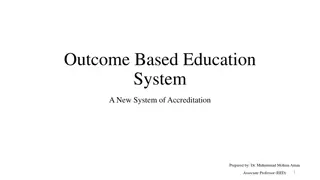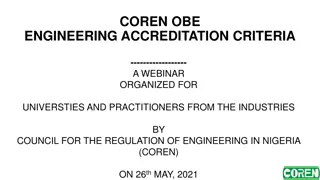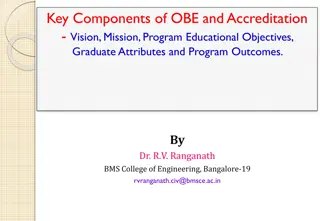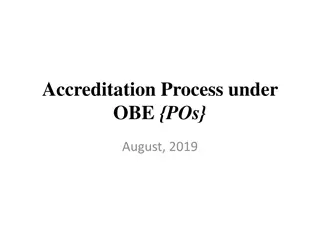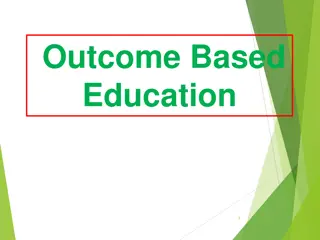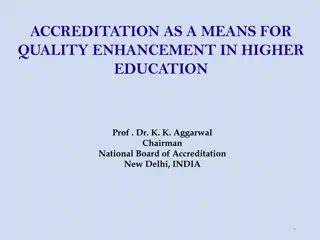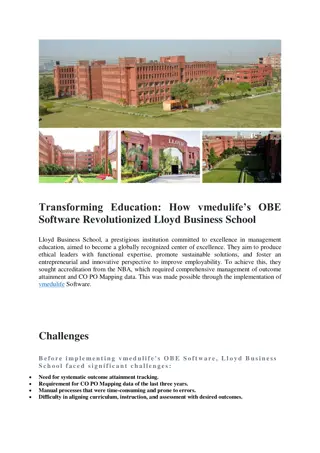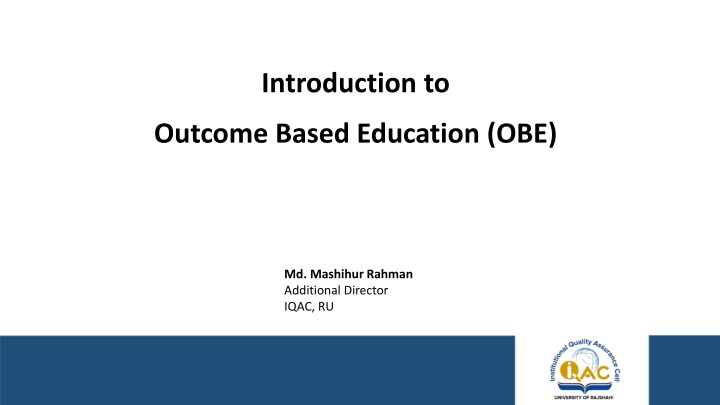
Outcome-Based Education (OBE) in Academic Settings
Outcome-Based Education (OBE) is a teaching and learning methodology focusing on achieving specific learning goals through curriculum restructuring, assessment practices, and student-centered approaches. It emphasizes measuring student performance and aligning educational processes with desired outcomes for continuous improvement.
Download Presentation

Please find below an Image/Link to download the presentation.
The content on the website is provided AS IS for your information and personal use only. It may not be sold, licensed, or shared on other websites without obtaining consent from the author. If you encounter any issues during the download, it is possible that the publisher has removed the file from their server.
You are allowed to download the files provided on this website for personal or commercial use, subject to the condition that they are used lawfully. All files are the property of their respective owners.
The content on the website is provided AS IS for your information and personal use only. It may not be sold, licensed, or shared on other websites without obtaining consent from the author.
E N D
Presentation Transcript
Introduction to Outcome Based Education (OBE) Md. Mashihur Rahman Additional Director IQAC, RU
What is Outcome Based Education (OBE) A system/teaching and learning methodology where parts and aspects (i.e. course design, delivery, assessment) of education are organized around a set of goals (outcomes). Students should achieve their goal by the end of the educational process. Maps and measures students performance at every step. Aims to maximize student learning outcomes by developing their knowledge & skills. Also referred to as standard based education, helping institutions measure their learning outcomes and enabling students to develop to stand out with their global counterparts.
OBE involves the restructuring of curriculum, assessment, and reporting practices in education to reflect the achievement of high- order learning and mastery rather than the accumulation of course credits. It requires students to demonstrate the knowledge and skills they have learnt and achieved. Outcome-based education means starting with a clear picture of what is important for students to be able to do, then organizing the curriculum, instruction, and assessment to make sure that this learning ultimately happens. (Spady, 1994). Spady, W.D. (1994) Outcome-Based Education: Critical Issues and Answers. American Association of School Administrators, Arlington.
OBE addresses the following key questions: What do you want the students to have or able to do? [Knowledge, Skills, ability to solve problems etc.] How can you best help students achieve it? [Student Centered Learning] How will you know whether they have achieved it? [Through various assessment schemes] HOW do we close the loop for further improvement [Continuous Quality Improvement (CQI)
Some important aspects/components of the Outcome Based Education Vision: futuristic statement that the institution would like to achieve over a long period of time. Mission: the means by which it propose to move toward the stated vision. Programme defined as the specialization or discipline of a Degree. interconnected arrangement of courses, co-curricular and extracurricular activities to accomplish predetermined objectives leading to the awarding of a degree.
Programme Learning Outcomes (PLOs) narrower statements that describe what students are expected to be able to do or attain by the time of graduation. relate to the skills, knowledge and behaviour that students acquire through the completion. expected to be aligned closely with Graduate Attributes. Program Educational Objectives (PEOs) the statements that describe the expected achievements of graduates in their career, and also in particular, what the graduates are expected to perform and achieve during the first few years after graduation.
Course: defined as a theory, practical or theory cum practical subject studied in a semester. Course Learning Outcome (CLO): statements that describe significant and essential learning that learners have achieved, and can reliably demonstrate at the end of a course. Mapping/Alignment: aligning objectives with outcomes (programme, course-level, contents). OBE tends to map at different levels by aligning itself to Bloom s Taxonomy s cognitive, affective, and psychomotor domains.
Rationale: a short description that makes clear the purpose and necessity of the course. It also describes the basis and context to understand how this course supports student learning and how it fits in the wider curriculum. Graduate Attributes (GA): attributes that are expected in a graduate from a programme.
Major Benefits Makes the programme student-centric Better tracking the learning in students Engaging with students in a better way More directed curriculum, reviewing and revising Better assessment Meeting accreditation requirements
Bangladesh Accreditation Council (BAC) Standards for Accreditation of Academic Program 1: Governance 2: Leadership, Responsibility and Autonomy 3: Institutional Integrity and Transparency 4: Curriculum 5: Teaching-Learning & Assessment 6: Student Admission & Support Services 7: Faculty & Professional Staff 8: Facilities & Resources 9: Research & Scholarly Activities 10: Monitoring, Evaluation & Continual Improvement
Bloom's Taxonomy of Learning A set of three hierarchical models used for the classification of educational learning objectives into levels of complexity and specificity. The model is named after Benjamin Bloom. During the 1990s, a new group of cognitive psychologists, led by Lorin Anderson (a former student of Bloom), updated the taxonomy reflecting relevance to 21st century perspective. Bloom, B. S. (1956). Taxonomy of educational objectives: The classification of educational goals (1st ed.). Longman Group. Anderson, L. W., Krathwohl, D. R., & Bloom, B. S. (2001). A taxonomy for learning, teaching, and assessing: A revision of Bloom s taxonomy of educational objectives. New York: Longman.
The three lists cover the learning objectives in cognitive, affective and psychomotor domains.
Use of Blooms Taxonomy 1. Defining the Learning Outcomes (LOs) & Educational Objectives 2. Selecting teaching methods/strategies 3. Selecting teaching aids-materials 4. Preparation of assessment tools 5. Development & review of curriculum
Cognitive Affective Psychomotor Learners' ability to process information in a meaningful way Learners demonstrate knowledge and comprehension of the subject matter and the ability to apply it to real life situations. Learners' attitudes and feeling that are a result of the learning process. involves the demonstration of feelings, attitudes, or sensitiveness toward other people, ideas or things. Learners' ability to use motor skills to learn measures the skills performance of the learner, therefore, the performance required will involve the manipulation of objects, tools, supplies, or equipment. includes the manner in which we deal with things emotionally, such as feelings, values, appreciation, enthusiasms, motivations, and attitudes. includes physical movement, coordination, and use of the motor-skill areas. Development of these skills requires practice and is measured in terms of speed, precision, distance, procedures, or techniques in execution. (Mental skills, Knowledge, Comprehension, Critical thinking) (Attitudes, Emotional reaction, Awareness) (Manual or physical skills)
Cognitive Affective Psychomotor Categories - Knowledge - Comprehension - Application - Analysis - Synthesis - Evaluation Categories - Receiving - Responding - Valuing - Organizing - Characterizing Categories - Perception - Set - Guided Response - Mechanism - Complex over response - Adaptation - Origination Revised ones - Remember - Understand - Apply - Analyze - Evaluate - Create
The hierarchy of the cognitive domain of Bloom's Taxonomy (1956).
Action Verbs by Domains Action Verbs by Domains 1
Selection of Teaching Methods: Cognitive Domain Sub-levels of Cognitive Domain Remember Teaching Methods Lecture, discussion, demonstration, cooperative learning, study tour, question-answer etc. Suggested reading, practices, home assignment, case study, role play Understand Apply Practice, problem solving, assignment etc Analyze Problem based learning, assignment, case study,brain storming, inquiry based learning Assignment, discussion, review work, Evaluate Create Debate, assignment, group work, competition
Selection of Teaching Methods: Affective Domain Sub-levels of Affective Domain Teaching Methods Receiving Lecture, directing reading, group discussion, demonstration,cooperative learning, study tour, question-answer etc Lecture, group discussion, cooperative learning, field trip, question-answer etc Suggested reading, lecture, discussion etc Responding Valuing Organizing Field trip, discussion, video, Role- playing Characterization Assignment, discussion, review work, practice
Selection of Teaching Methods: Psychomotor Domain Sub-levels of Psychomotor Domain Teaching Methods Imitation Manipulation Precision Articulation Naturalization Observation, Practice, demonstration, video Practice, Do it by yourself, exercise Practice & practice, feedback, exercise Practice, observation, exercise Practice under adverse condition

